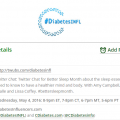Keeping Healthy is a Family Affair
By Martha Funnell, MS, RN, CDE

You and your family can work together to create a road map to lower your risks for diabetes, health disease and other health problems.
First, the not-so-good news: Type 2 diabetes runs in families. This means that if you have diabetes, your children, grandchildren, brothers and sisters are all at risk. Now, here is the good news: As the National Diabetes Education Program points out, you can’t change your genes, but you can change your future— and you can help your family members change their futures as well.
PREVENTING DIABETES
A large study was done several years ago called The Diabetes Prevention Program (DPP). The study looked at over 3,000 people with higher than normal blood glucose levels. While their levels were not high enough to cause them to be diagnosed with diabetes, they did show that those people had a condition called prediabetes. Almost half of the people in the study were members of racial groups with high rates of type 2 diabetes: African-Americans, Hispanic-Americans, Asian-Americans, Pacific Islanders and American Indians.
The study also included other groups of people at higher risk for type 2 diabetes, such as people aged 60 and over, women with a history of diabetes during pregnancy, and people with a parent, sibling or other relative with type 2 diabetes.
The goal of the study was to see what people can do to help prevent the onset of diabetes. Of the people who took part in the study, one group reduced its risk for getting Type 2 diabetes by 58%. On average, this group exercised a total of 30 minutes per day, usually by walking or another moderate activity. They also lost 5% to 7% of their body weight, an average of 15 pounds.
Getting more active and losing weight helped all age and ethnic groups, but it was especially helpful for the elder group. They reduced their risk for diabetes by 71% with these lifestyle changes.
Another way to prevent diabetes is with medication. A different group that took part in the study was given metformin, a pill that is used to treat diabetes. People in the group that took metformin reduced their risk of getting Type 2 diabetes by about one-third. This medicine worked better in people who were younger and very overweight.
HELPING YOUR FAMILY MEMBERS
- Understand the risks.
Your family members need to know that you have diabetes so they can understand their own risk for diabetes. Although it is tempting not to tell them so that you can keep them from worrying, they need to know so that they can take their risk seriously. Some people use the chance to tell family members as a way to start talking about what they are doing to take care of their diabetes. Let them know that you are telling them about your condition because you care about them and want to help them be healthier. We know that people with diabetes are better able to manage their condition and their feelings about it when they have the love, support and understanding of their family and friends.
- Make a plan.
Ask your family members to help you make a plan for managing your diabetes. Then talk about how you can help them to take steps to eat healthier and be more active. This way, you are both supporting each other in having healthy lifestyle plans. For example, you may talk about how to have healthier choices on the menu when you all get together for a meal. If you live close to one another, you may decide to walk or do other kinds of exercise together. Knowing that you are all working toward a common goal can bring your family closer. Supporting each other helps everyone to succeed.
- Include your children.
Include children and grandchildren in your planning. The number of young people with type 2 diabetes is growing rapidly. Together, come up with a plan to keep them active and at a healthy weight. Turning off the TV, iPad, computer and cell phone and taking a walk or going to the park are good ways to connect and be active at the same time.
- Community involvement.
Think about ways you can involve your community, place of worship or school in diabetes prevention efforts. Support groups, walking clubs and community gardens are great ways to bring the neighborhood together. Encouraging healthier choices in the school cafeteria and other events where food is served will help everyone.
Managing diabetes is not always easy but it is worth the effort. The same is true for lowering your risk for diabetes. Making a plan and providing and receiving support can help every person to be more successful.
Type 2 diabetes tends to run in families. Despite what you may have heard, diabetes does not “skip a generation.” You are more likely to get diabetes if your father or mother had it.











